|
- Capture of Sprinkler
Irrigation by Container-Grown Nursery Crops
-
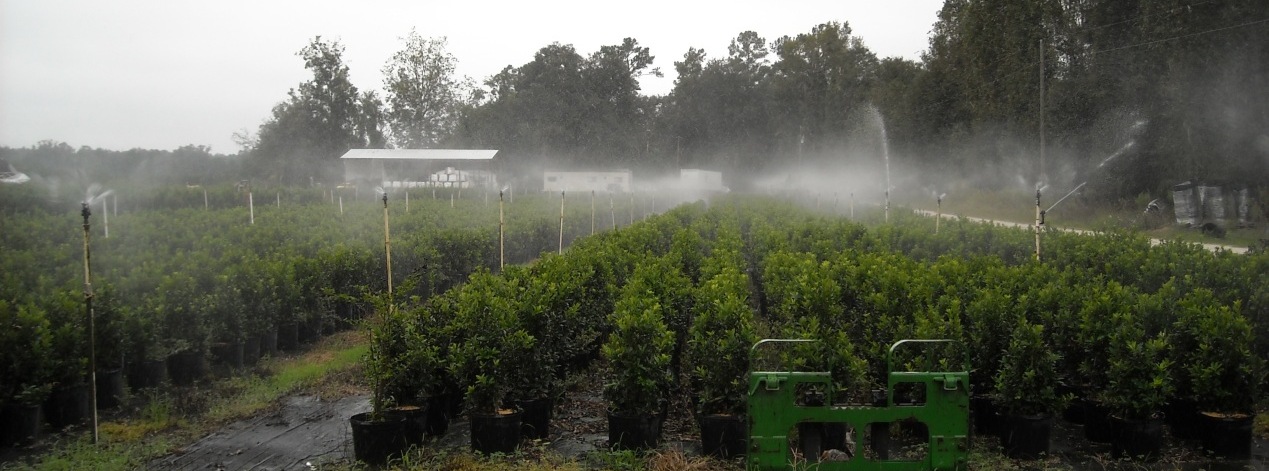 -
- For printable capture factor information cards click here
-
- Capture
factor research sponsored by:
 -
- Background
-
- Plants
growing in containers can channel sprinkler irrigation water into
the container that would otherwise fall un-intercepted between
containers. This effect has significant implications for adjusting
irrigation rates to accurately deliver required amounts of water to
containers. The capture
factor (CF)
is used to describe the water-capturing ability of container-grown
plants. In general terms:
-

-
- CF
is affected by several factors including plant species, plant size,
leaf area, container size, and container spacing. For example, a
plant with a CF = 1 (no effect) when small may exhibit a
significantly larger CF when more fully grown (Fig. 1). Or, a plant
may exhibit a high CF when spaced far apart but a low CF when spaced
close together. The dynamic nature of CF presents challenges for CF
monitoring/prediction in container nurseries that irrigate a wide
range of plant species at various stages of production.
-
- In
this fact sheet we present results from research sponsored by the
Southwest Florida Water Management District that describe how CF can
be affected by plant species, plant size, and container size and
spacing. We also provide an example calculation of how CF can be
used to more efficiently irrigate container-grown nursery crops.
- Research
Methods
-
- Irrigation test site
-
A
20 ft x 20 ft irrigation zone at the University of Florida,
Gainesville, was used for CF testing (Fig.
2). Impact sprinkler heads (Rainbird® Maxijet 2045PJ-08,
No. 8 nozzles - 3 gpm at a
trajectory of 23 degrees) on 4-ft tall risers fitted with 30 psi
pressure regulators were situated at each of the four corners of the
irrigation zone. Spray patterns were adjusted to achieve a Christiansen’s Uniformity
Coefficient (UC) 95% and a delivery rate of 0.56 inch/hour.
See edis.ifas.ufl.edu/ae384
for more on irrigation uniformity.
-
- Effect
of plant species and container size on CF
- Ornamental
shrubs grown in trade #1 (6-7 inch diameter) and #3 (10-11 inch
diameter) containers and representing seven different growth habits
were surveyed for their capacity to capture sprinkler irrigation
water. Plants were obtained from commercial nurseries and
transported to Gainesville for testing. Plants chosen were of
marketable or near-marketable size as larger-sized plants exhibit
the greatest water-capturing effect. A list of the plant species
tested is given in Table 1; photos of test plants are given in Fig.
3 (trade #1) and Fig. 4 (trade #3).
-
- For
CF tests, 10 plants of each species were placed on 2-ft centers in
an equidistant, triangular pattern (Fig.
5). The wide spacing
arrangement ensured that CF values would not be limited by
competition from adjacent plants. Containers were placed in pails to
collect leachate during irrigation tests. A plastic or aluminum foil
skirt was used to form a barrier between container and pail to
prevent irrigation water from directly entering leachate pail (Fig.
6).
-
- For
CF irrigation test runs, each container-pail assembly was weighed
before and after irrigation. Three irrigation test runs were made
for each plant species-container size giving a total of 30
measurements per plant species-container size. The difference in
weight before and after irrigation was used to calculate the volume
of water captured by the container with plant (Vp)
based on the density of water (1 g= 1 cm3).
-
- The
amount of water that would be captured by containers without a plant
was determined by placing empty collection pails in irrigation test
area and applying the same amounts of irrigation water. The
following equation was used to calculate the amount of water
captured by containers without a plant (Vo):
-

-
- Based
on Vp
and Vo,
the capture factor CF was calculated for each species-container
size:
-

-
- Effect
of plant size and container spacing on CF
- For
these tests, we selected three plant species from those surveyed in
the previously described experiment:
-
1)
Juniperus
chinensis
‘Parsonii’ – Parsonii juniper
-
2)
Raphiolepis
indica –
Indian hawthorn
-
3)
Ligustrum
japonicum
– Waxleaf ligustrum.
-
Three
sizes (small, medium, large) of each of the three plant species in
both trade #1 and #3 containers were obtained from a commercial
nursery. For each plant species-size, we measured CF at 3-4
container spacings ranging from close together to far apart. CF was
measured using the methods described previously.
- Results
of CF testing
-
- Effect
of plant species and container size on CF
- CF
values for marketable-sized plants ranged from 1.2 to 4.2 depending
upon container size and plant species (Table 1). CF values were
greater for trade #3 than for trade #1 containers (2.9 vs. 2.1),
which is attributed to the greater canopy volume per top area of
container. The ratio of plant volume to container top area was 8
(1590 cm3 per 200 cm2 top area) for trade #1 and 11 (6390 cm3 per
560 cm2 top area) for trade #3 containers. Greater canopy volume
per container top area implies relatively greater leaf structure for
capturing irrigation water.
-
- Plant
species exhibited a wide range of CF values. Lowest CF values (1.2
and 1.6) were observed for the groundcover Agapanthus
africanus which
had low, arch-shaped leaves (Figs. 3 and 4). The downward shape of
the leaves outside the container perimeter likely resulted in the
relatively low CF values. The globose-shaped azalea (Rhododendron
sp.
‘Red Ruffle’) also exhibited relatively low CFs (1.5 and 1.8).
Three other small-leaved species, Buxus
microphylla japonica,
Ilex cornuta,
and Ilex
vomitoria,
exhibited moderate CF values ranging from 1.7 to 2.9. Another two
species exhibiting moderate CF values included the spreading vine
Jasmine
multiflorum and
the broad-spreading Juniperus
chinensis
‘Parsonii’. For J.
multiflorum,
branches tended to droop outside container perimeter so that even
though plants were tall and wide, channeling was moderate. For J.
chinensis, low
plant height from broad-spreading habit appeared to limit ability of
canopy to channel water into container.
-
- Highest
CF values (2.3-4.2) were observed for several woody shrubs with
upright-spreading growth habit: Ligustrum
japonicum,
Podocarpus
spp., and Viburnum
odoratissiumum.
A fourth species, Raphiolepis
indica, also
exhibited high CF (2.5 and 3.9). Although R.
indica’s habit
is spreading, branches within the canopy are stiff and upright
resulting in high CF despite relatively low height to width ratio.
- Based on the range of CF
values observed, we can categorize plant species into three groups:
-
a)
Low capturing ability (CF <2)
- b)
Moderate capturing ability (CF 2-3)
-
c)
High capturing ability (CF >3).
-
Plants
classified as ground cover or globose exhibited low CFs, semi-broad
spreading, spreading vine, and broad spreading habits moderate CFs,
and upright and spreading habits to have moderate to high CFs.
Large-leafed species and species with greater height to width ratios
tended to have higher CFs than plant species with small leaves and
more spreading growth.
-
- Effect
of plant size and container spacing on CF
- CF
increased as plant size of each plant species increased (Table 2).
It should be noted that CF results in Table 2 were observed at the
widest spacing tested and, therefore, represent the maximum CF
observed for each plant size.
-
- For
each plant species and size, measured CF decreased when containers
were spaced closed together (Table 3 and 4). The reason for this is
that when containers are spaced close together, there is a limited
amount of water that can be captured outside each container. Table
5 and 6 shows how theoretical maximum CF values decrease as
containers become more closely spaced. Maximum values in Table 4
are based on the principle that the irrigation water captured is
limited to the area allotted each container divided by the container
top area:
- CFmax
=
At/Ac
-
where
At
= total area allotted each container (cm2)
and Ac
= top area of container (cm2).
The calculation depends on the container placement pattern. For
square pattern,
At
= (container diameter + spacing between adjacent containers)2,
-
and
for equidistant, triangular spacing,
At
= (container diameter + spacing between adjacent containers)2
* 0.866.
-
The calculation for top area of
the container is:
Ac=
π * r2
= π * (container diameter/2)2.
-
- We
can see from these results that CF is a function of plant species,
plant and container size but may be limited by close container
spacings. For example, large #1 Ligustrum
japonicum had a
CF of 2.9 when spaced 6 inches apart but only 1.8 when spaced 1.5
inches apart. In this case CF was limited at the 1.5 inch spacing
where theoretical CFmax
was 1.5. Similarly, large #3 L.
japonicum had a
CF of 4.0 when spaced 15 inch apart but only 2.9 when spaced 6
inches apart. In this case theoretical CFmax
was 2.7 at the closer 6 inch spacing.
-
- Using
CF to improve irrigation efficiency
-
- CF
is important for adjusting irrigation rates to deliver a prescribed
amount of water to containers. For example, if the container water
deficit was determined to be 0.5 inch, a grower NOT considering CF
would apply 0.5 inches of irrigation water. However, if it was
determined that CF=2, the grower would know that 0.5 inches of
irrigation would supply 1.0 inch or twice the desired irrigation
amount to containers. Knowing CF, the grower could irrigate with
0.25 inches to deliver 0.5 inches of water to the containers. The
general equation for adjusting irrigation is:
-
- Irrigation
(inch) = Container water deficit (inch) ÷ CF
- Example
calculation
-
If
container water deficit = 0.6 inches and CF = 1.7, then
-
- Irrigation
=
0.6 inch ÷ 1.7 = 0.35
inch
-
- The
above example demonstrates the potential value of using CF. Using
CF to adjust irrigation rates in this example saved 0.25 inch of
irrigation water (0.6 vs. 0.35 inch).
-
- Even
if the container water deficit is not known, CF can be used to group
plants with similar irrigation requirements. For example, all
factors being equal, i.e., same plant size, container size and
spacing, growers could group plant species based on CF (Table 1). A
working knowledge of CF, including the ability to measure CF in the
field, is paramount if sprinkler irrigation water is to be applied
efficiently in container nurseries.
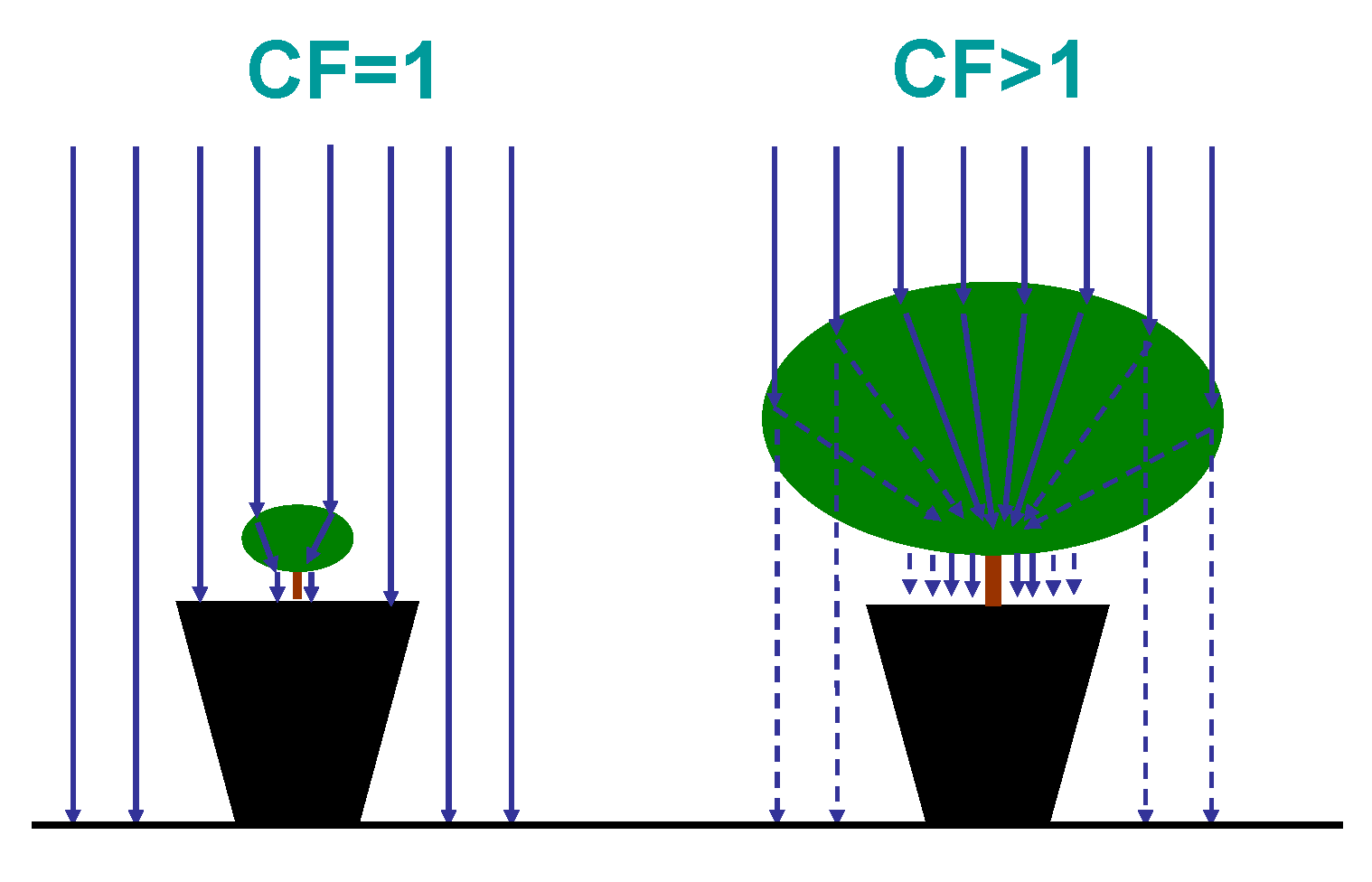
-
Fig. 1. Capture factor (CF) values
>1 indicate that the plant canopy is channeling water into the
container that would otherwise fall between containers.
-
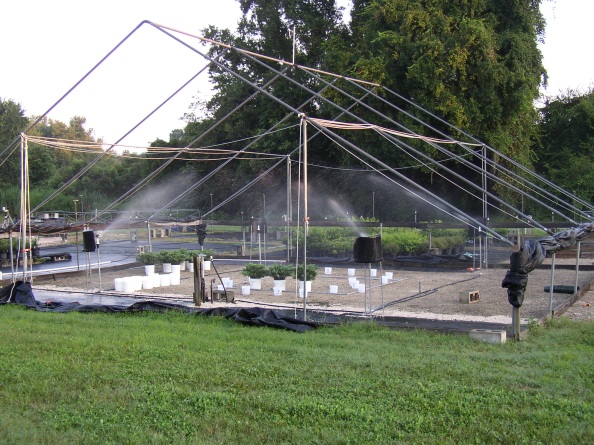 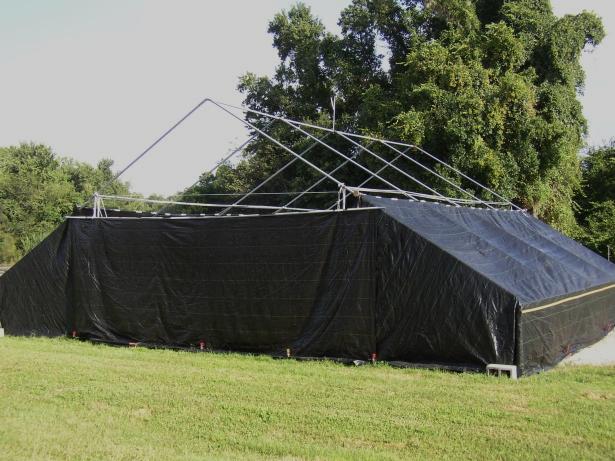 -
Fig.
2. Site used for CF testing at the University of Florida. Side
curtains were used to protect irrigation area from winds during
tests.
-
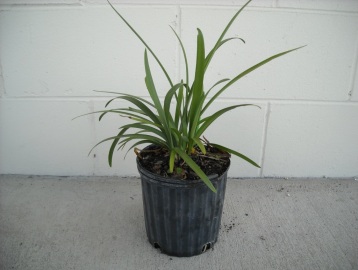
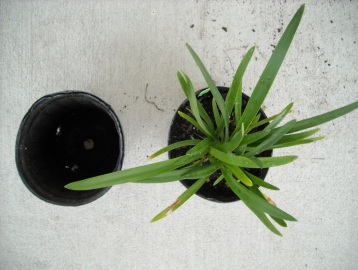 Agapanthus
africanus
Agapanthus
africanus-
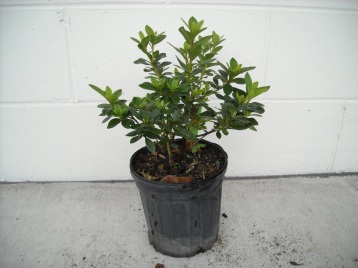
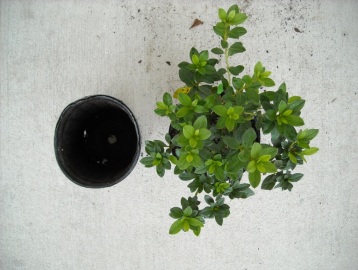 Rhododendron
x ‘Red Ruffle’
Rhododendron
x ‘Red Ruffle’-

 Juniperus
chinensis ‘Parsonii’
Juniperus
chinensis ‘Parsonii’-

 Jasminum
multiflorum
Jasminum
multiflorum-
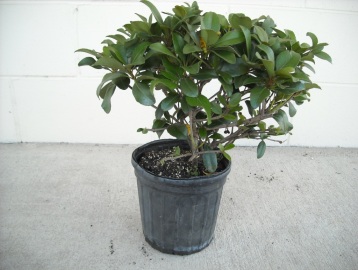
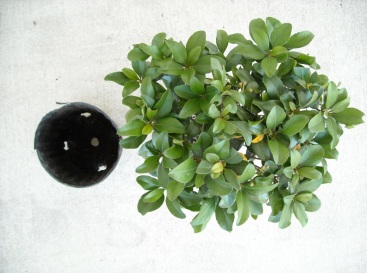 Raphiolepis
indica
Raphiolepis
indica-

 Ilex
vomitoria ‘Schellings Dwarf’
Ilex
vomitoria ‘Schellings Dwarf’-
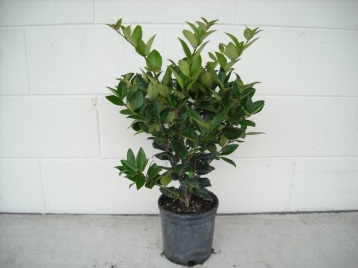
 Ligustrum
japonicum
Ligustrum
japonicum-

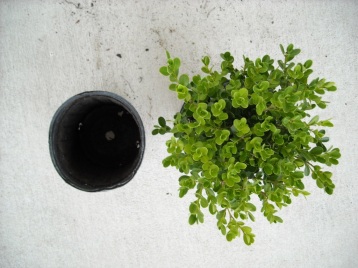 Buxus
microphylla japonica
Buxus
microphylla japonica-

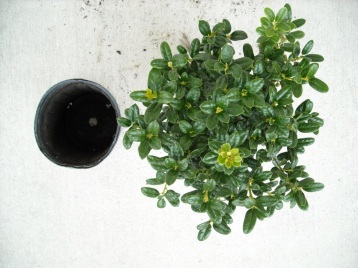 Ilex
cornuta Burfordii ‘Nana’
Ilex
cornuta Burfordii ‘Nana’-
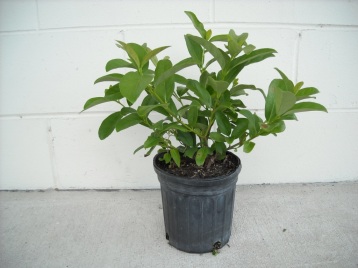
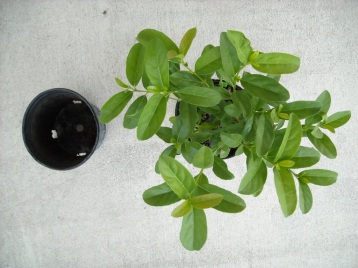 Viburnum
odoratissimum
Viburnum
odoratissimum-
Fig. 3. Photos of plant species
grown in trade #1 containers used in CF survey testing.
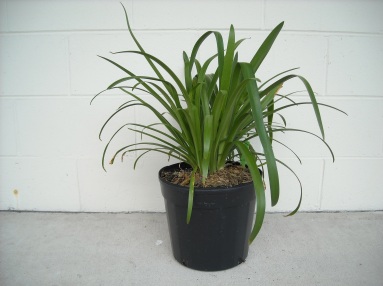
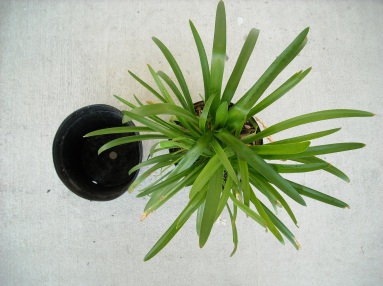 Agapanthus
africanus
Agapanthus
africanus-
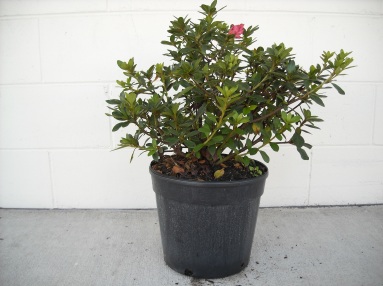
 Rhododendron
x ‘Red Ruffle’
Rhododendron
x ‘Red Ruffle’-

 Juniperus
chinensis ‘Parsonii’
Juniperus
chinensis ‘Parsonii’-
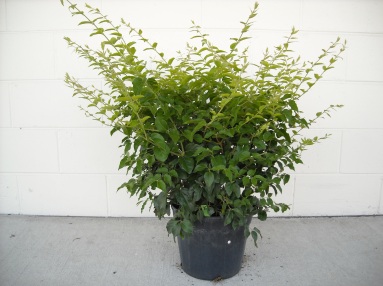
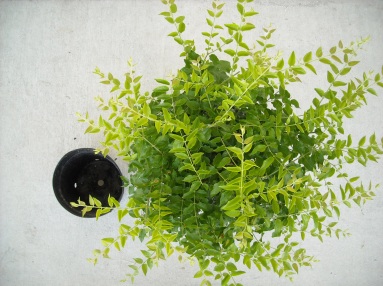 Jasminum
multiflorum
Jasminum
multiflorum-
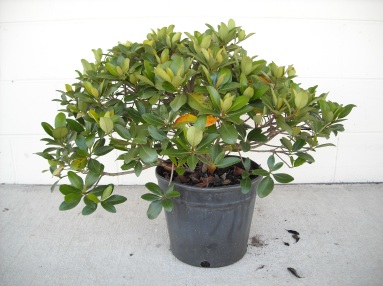
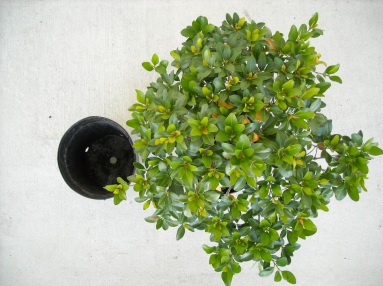 Raphiolepis
indica
Raphiolepis
indica-
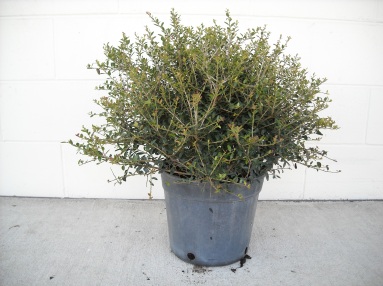
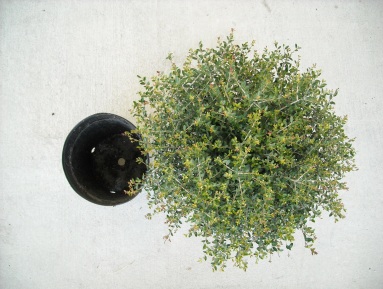 Ilex
vomitoria ‘Schellings Dwarf’
Ilex
vomitoria ‘Schellings Dwarf’-

 Ligustrum
japonicum
Ligustrum
japonicum-
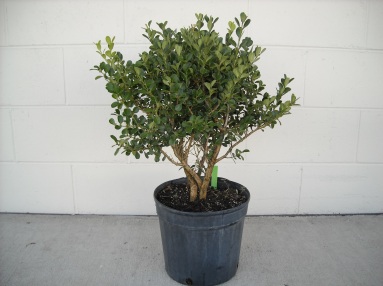
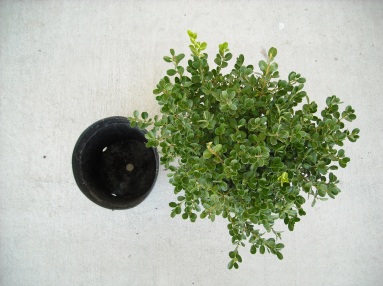 Buxus
microphylla japonica
Buxus
microphylla japonica-
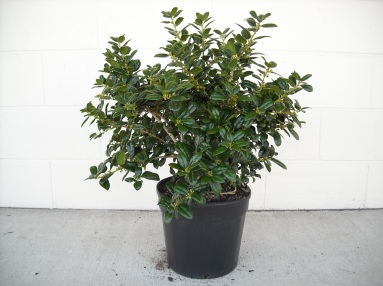
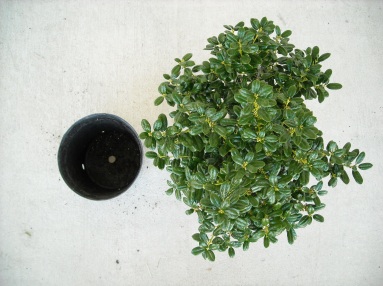 Ilex
cornuta Burfordii ‘Nana’
Ilex
cornuta Burfordii ‘Nana’-
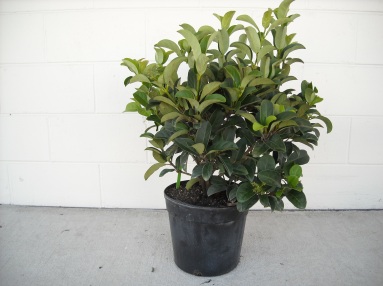
 Viburnum
odoratissimum
Viburnum
odoratissimum
- Fig.
4. Photos of plant species grown in trade #3 containers used in CF
survey testing.
-

-
Fig.
5. For plant species testing, containers were placed on 2-ft centers
in a triangular, equidistant pattern.
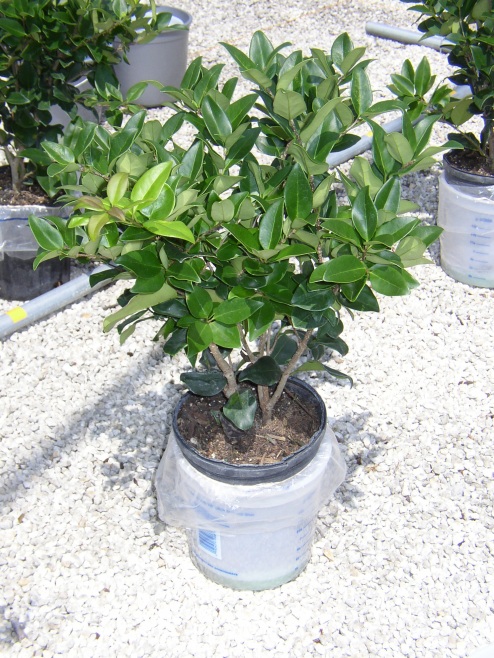 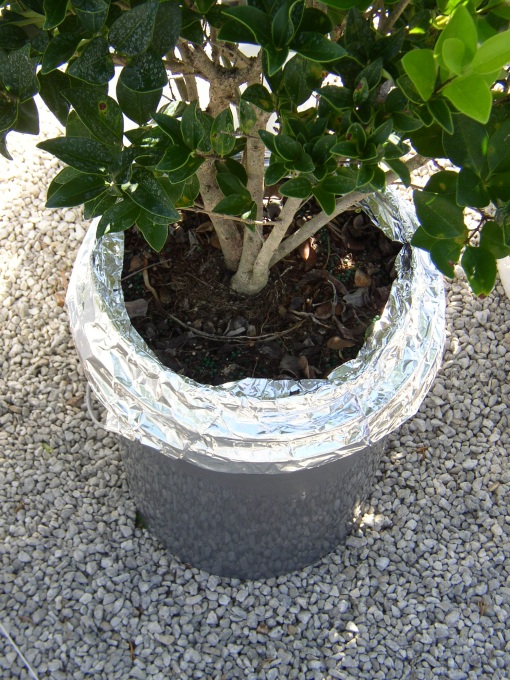
Fig. 6. Plastic or aluminum
foil skirts were placed between collection pail and container to
prevent irrigation water from directly entering collection pail.
- Table
1. Plant species tested for their capacity to capture overhead
irrigation water. The capture factor (CF) is the relative volume of
water intercepted by the container with a plant in relation to what
would be intercepted without a plant. Capture factor values were
measured at wide container spacings and therefore represent maximum
values.
-
|
Habit1 |
Species |
Container
Size2 |
Height
(inch) |
Width
(inch) |
CF |
|
GC |
Agapanthus
africanus |
#1 |
7 |
13 |
1.2 |
|
|
|
#3 |
15 |
23 |
1.6 |
|
US |
Buxus
microphylla japonica |
#1 |
10 |
10 |
1.7 |
|
|
|
#3 |
20 |
17 |
2.4 |
|
US |
Ilex
cornuta ‘Burfordii Nana’ |
#1 |
12 |
13 |
1.7 |
|
|
|
#3 |
19 |
21 |
1.8 |
|
SBS |
Ilex
vomitoria ‘Schillings Dwarf’ |
#1 |
9 |
13 |
1.8 |
|
|
|
#3 |
13 |
24 |
2.9 |
|
SV |
Jasminum
multiflorum |
#1 |
ND |
ND |
ND |
|
|
|
#3 |
24 |
35 |
2.3 |
|
BS |
Juniperus
chinensis ‘Parsonii’ |
#1 |
11 |
19 |
2.0 |
|
|
|
#3 |
11 |
28 |
2.4 |
|
US |
Ligustrum
japonicum |
#1 |
17 |
18 |
3.1 |
|
|
|
#3 |
30 |
29 |
4.1 |
|
US |
Podocarpus
spp. |
#1 |
25 |
18 |
3.2 |
|
|
|
#3 |
37 |
24 |
4.1 |
|
S |
Raphiolepis
indica |
#1 |
10 |
15 |
2.5 |
|
|
|
#3 |
14 |
28 |
3.9 |
|
GL |
Rhododendron
x ‘Red Ruffle’ |
#1 |
9 |
12 |
1.5 |
|
|
|
#3 |
14 |
18 |
1.8 |
|
US |
Viburnum
odoratissimum |
#1 |
13 |
17 |
2.3 |
|
|
|
#3 |
26 |
28 |
4.2 |
- 1GC=ground
cover, US=upright spreading, SBS=semi broad spreading, SV=spreading
vine, BS=broad spreading, S=spreading, GL=globose
2Container
diameter was 6 inches for trade #1 and 10.5 inches for trade #3
containers
- Table
2. Effect of plant size on measured capture factor (CF) for three
woody ornamental species in either trade #1 or #3 containers. The
capture factor is the volume of irrigation water intercepted by the
container with a plant in it relative to what would be intercepted
without the plant. Capture factor may be less if limited by
container spacing (see Tables 3 and 4).
-
|
Species |
Container
Size1 |
Container
spacing2
(inch) |
Plant
size |
Height
(inch) |
Width
(inch) |
CF |
|
Juniperus
chinensis ‘Parsonii’ |
#1 |
6 |
small |
8 |
10 |
1.1 |
|
(Parsonii
juniper) |
|
6 |
medium |
10 |
14 |
2.0 |
|
|
|
6 |
large |
11 |
17 |
2.7 |
|
|
#3 |
9 |
small |
10 |
17 |
1.3 |
|
|
|
12 |
medium |
15 |
23 |
1.9 |
|
|
|
15 |
large |
16 |
27 |
1.9 |
|
Raphiolepsis
indica |
#1 |
6 |
small |
7 |
10 |
1.4 |
|
(Indian
hawthorn) |
|
9 |
medium |
8 |
12 |
1.8 |
|
|
|
9 |
large |
10 |
15 |
2.4 |
|
|
#3 |
9 |
small |
11 |
16 |
1.6 |
|
|
|
12 |
medium |
11 |
21 |
2.0 |
|
|
|
15 |
large |
13 |
25 |
2.9 |
|
Ligustrum
japonicum |
#1 |
6 |
small |
12 |
12 |
2.0 |
|
(Waxleaf
ligustrum) |
|
9 |
medium |
14 |
15 |
2.6 |
|
|
|
9 |
large |
18 |
20 |
3.3 |
|
|
#3 |
12 |
small |
20 |
21 |
2.4 |
|
|
|
15 |
medium |
23 |
25 |
3.0 |
|
|
|
15 |
large |
32 |
32 |
4.0 |
- 1Trade
#1 container diameter = 6.4 inches; trade #3 container diameter = 10
inches
-
2Widest
of four spacing tested; spacing is distant between adjacent
containers in equidistant, triangular pattern�
Table
3. Measured CF values for trade #1 (6.4-inches diameter) containers
at various container spacings. CF values are the average of 30
measurements.
|
Plant species |
Plant
size2 |
Distance
between adjacent containers (inch)1 |
|
|
0 |
1.5 |
2 |
3 |
4 |
6 |
|
Juniperus
chinensis |
Small
(8, 10) |
1.1 |
- |
1.1 |
- |
|
1.1 |
|
|
Medium
(10, 14) |
- |
- |
1.7 |
- |
1.9 |
2.0 |
|
|
Large
(11, 17) |
- |
- |
2.0 |
- |
2.4 |
2.7 |
|
Raphiolepis
indica |
Small
(7, 10) |
1.2 |
1.4 |
- |
1.4 |
- |
1.3 |
|
|
Medium
(8, 12) |
- |
1.6 |
- |
1.8 |
- |
1.9 |
|
|
Large
(10, 15) |
- |
1.6 |
- |
1.8 |
- |
2.5 |
|
Ligustrum
japonicum |
Small
(12, 12) |
1.3 |
1.6 |
- |
1.9 |
- |
2.0 |
|
|
Medium
(15, 15) |
- |
1.9 |
- |
2.2 |
- |
2.6 |
|
|
Large
(18, 20) |
- |
1.8 |
- |
2.1 |
- |
2.9 |
- 1Equidistant,
triangular pattern
-
2Numbers
in parentheses are average plant height and plant width in inches
Table
4. Measured CF values for trade #3 (10-inches diameter) containers
at various container spacings. CF values are the average of 30
measurements.
|
Plant species |
Plant
size2 |
Distance
between adjacent containers (inch)1 |
|
|
3 |
6 |
9 |
12 |
15 |
|
Juniperus
chinensis |
Small
(10, 17) |
1.3 |
1.3 |
1.3 |
- |
- |
|
|
Medium
(15, 13) |
- |
1.7 |
1.7 |
1.9 |
- |
|
|
Large
(16, 27) |
- |
1.8 |
1.9 |
1.9 |
1.9 |
|
Raphiolepis
indica |
Small
(11, 16) |
1.5 |
1.6 |
1.5 |
- |
- |
|
|
Medium
(11, 21) |
1.7 |
1.9 |
2.0 |
2.0 |
- |
|
|
Large
(13, 25) |
- |
- |
2.4 |
2.6 |
2.9 |
|
Ligustrum
japonicum |
Small
(20, 21) |
1.8 |
2.0 |
2.1 |
2.4 |
- |
|
|
Medium
(23, 25) |
- |
2.5 |
2.9 |
3.0 |
3.0 |
|
|
Large
(32, 32) |
- |
2.9 |
3.5 |
3.9 |
4.0 |
- 1Equidistant,
triangular pattern
-
2Numbers
in parentheses are average plant height and plant width in inches
-
Table
5. Theoretical maximum CF values for various spacing arrangements
for trade #1 (6-inch diameter) containers.
|
Pattern |
Spacing between
containers (inch) |
|
0 |
1 |
2 |
3 |
4 |
5 |
6 |
|
Square |
1.3 |
1.7 |
2.2 |
2.8 |
3.4 |
4.1 |
4.9 |
|
Triangular |
1.1 |
1.5 |
1.9 |
2.4 |
3.0 |
3.6 |
4.2 |
Table
6. Theoretical maximum CF values for various spacing arrangements
for trade #3 (10.5-inch diameter) containers.
|
Pattern |
Spacing between
containers (inch) |
|
0 |
3 |
6 |
9 |
12 |
15 |
18 |
|
Square |
1.3 |
2.1 |
3.1 |
4.4 |
5.9 |
7.5 |
9.4 |
|
Triangular |
1.1 |
1.8 |
2.7 |
3.8 |
5.1 |
6.5 |
8.1 |
The
information contained herein has not been subjected to scientific
peer review and is not a recommendation of UF/IFAS.
Jeff Million and Tom Yeager, Dept. of
Environmental Horticulture, Feb. 6, 2012
|






 Agapanthus
africanus
Agapanthus
africanus
 Rhododendron
x ‘Red Ruffle’
Rhododendron
x ‘Red Ruffle’
 Juniperus
chinensis ‘Parsonii’
Juniperus
chinensis ‘Parsonii’
 Jasminum
multiflorum
Jasminum
multiflorum
 Raphiolepis
indica
Raphiolepis
indica
 Ilex
vomitoria ‘Schellings Dwarf’
Ilex
vomitoria ‘Schellings Dwarf’
 Ligustrum
japonicum
Ligustrum
japonicum
 Buxus
microphylla japonica
Buxus
microphylla japonica
 Ilex
cornuta Burfordii ‘Nana’
Ilex
cornuta Burfordii ‘Nana’
 Viburnum
odoratissimum
Viburnum
odoratissimum
 Agapanthus
africanus
Agapanthus
africanus
 Rhododendron
x ‘Red Ruffle’
Rhododendron
x ‘Red Ruffle’
 Juniperus
chinensis ‘Parsonii’
Juniperus
chinensis ‘Parsonii’
 Jasminum
multiflorum
Jasminum
multiflorum
 Raphiolepis
indica
Raphiolepis
indica
 Ilex
vomitoria ‘Schellings Dwarf’
Ilex
vomitoria ‘Schellings Dwarf’
 Ligustrum
japonicum
Ligustrum
japonicum
 Buxus
microphylla japonica
Buxus
microphylla japonica
 Ilex
cornuta Burfordii ‘Nana’
Ilex
cornuta Burfordii ‘Nana’
 Viburnum
odoratissimum
Viburnum
odoratissimum


